Holistic Nursing Care Plan: Post-Op Cataract and Mental Health
VerifiedAdded on 2023/06/07
|7
|1660
|398
Report
AI Summary
This nursing care plan focuses on Paul Eddie, a patient recovering from cataract surgery with pre-existing conditions of hepatitis C, depression, and diabetes. The plan addresses two primary issues: disturbed sensory perception due to sore eyes and blurry vision, and symptoms of depression, isolation, and self-esteem disturbances. Interventions include environmental modifications to reduce fall risk, monitoring post-operative complications, pain management, and promoting independence. For depression and isolation, the plan emphasizes social engagement, referral to aboriginal community health services for culturally appropriate care, counselling, and building a strong support network to improve Paul's overall well-being and healthcare equity. The care plan is supported by evidence-based practices and aims to enhance Paul's quality of life by addressing both physical and mental health needs.
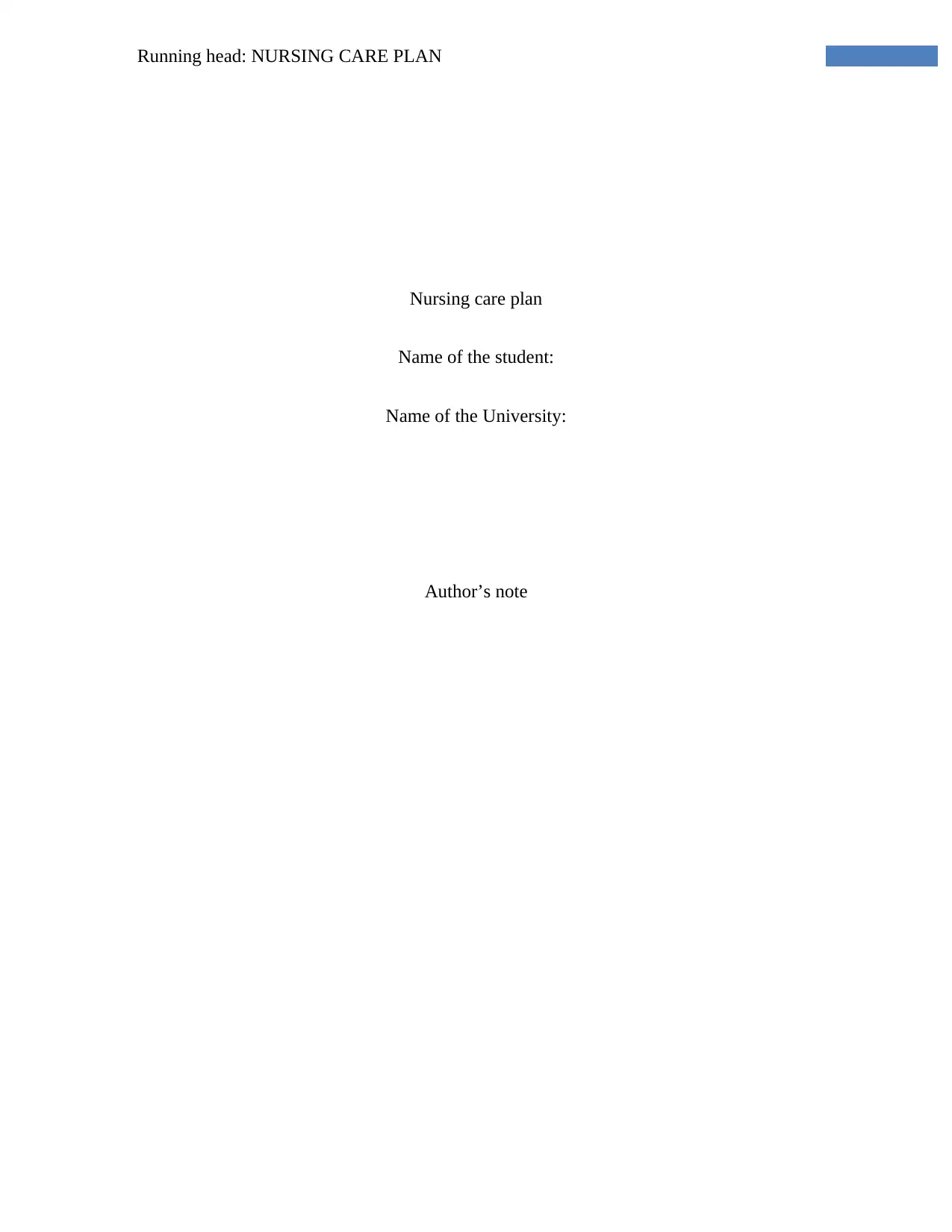
Running head: NURSING CARE PLAN
Nursing care plan
Name of the student:
Name of the University:
Author’s note
Nursing care plan
Name of the student:
Name of the University:
Author’s note
Paraphrase This Document
Need a fresh take? Get an instant paraphrase of this document with our AI Paraphraser
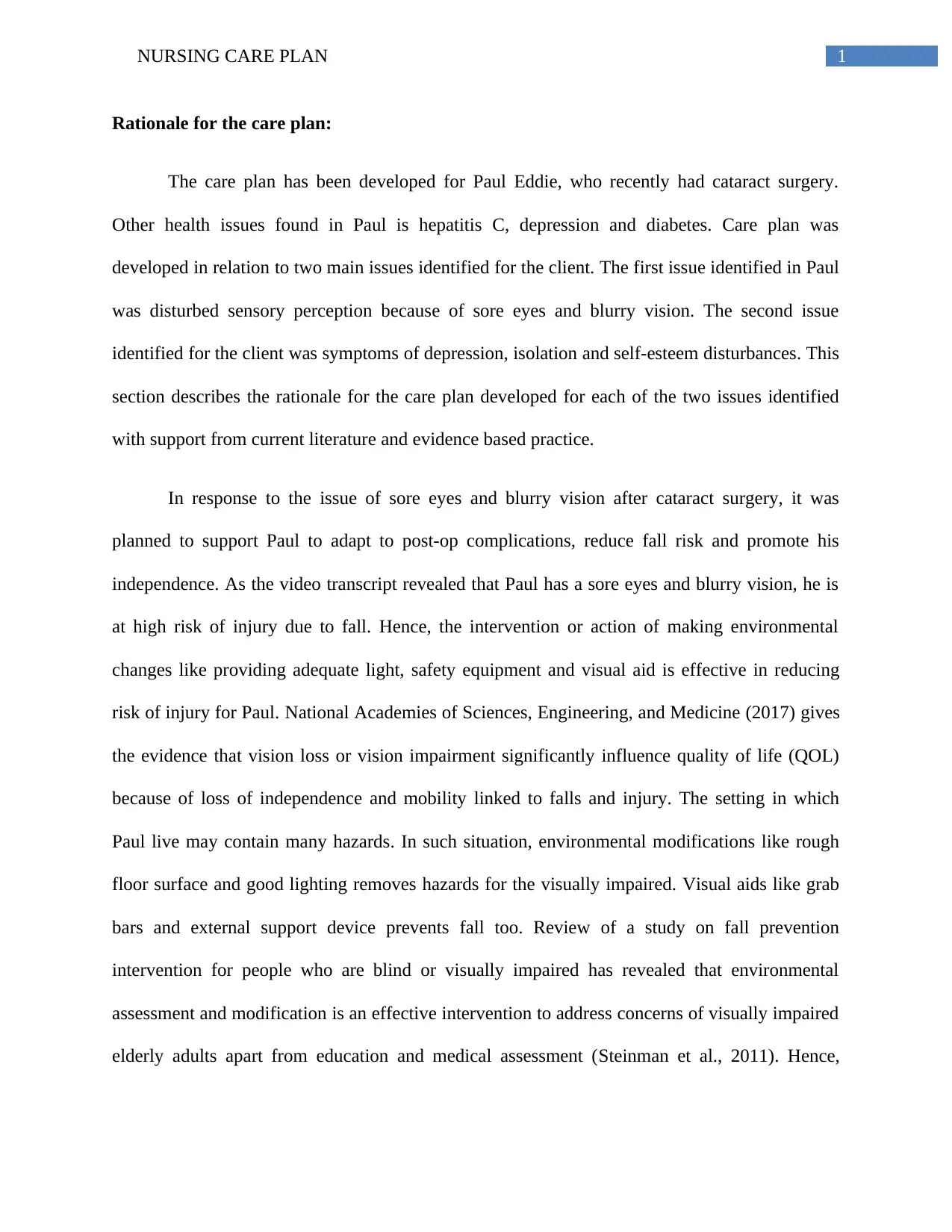
1NURSING CARE PLAN
Rationale for the care plan:
The care plan has been developed for Paul Eddie, who recently had cataract surgery.
Other health issues found in Paul is hepatitis C, depression and diabetes. Care plan was
developed in relation to two main issues identified for the client. The first issue identified in Paul
was disturbed sensory perception because of sore eyes and blurry vision. The second issue
identified for the client was symptoms of depression, isolation and self-esteem disturbances. This
section describes the rationale for the care plan developed for each of the two issues identified
with support from current literature and evidence based practice.
In response to the issue of sore eyes and blurry vision after cataract surgery, it was
planned to support Paul to adapt to post-op complications, reduce fall risk and promote his
independence. As the video transcript revealed that Paul has a sore eyes and blurry vision, he is
at high risk of injury due to fall. Hence, the intervention or action of making environmental
changes like providing adequate light, safety equipment and visual aid is effective in reducing
risk of injury for Paul. National Academies of Sciences, Engineering, and Medicine (2017) gives
the evidence that vision loss or vision impairment significantly influence quality of life (QOL)
because of loss of independence and mobility linked to falls and injury. The setting in which
Paul live may contain many hazards. In such situation, environmental modifications like rough
floor surface and good lighting removes hazards for the visually impaired. Visual aids like grab
bars and external support device prevents fall too. Review of a study on fall prevention
intervention for people who are blind or visually impaired has revealed that environmental
assessment and modification is an effective intervention to address concerns of visually impaired
elderly adults apart from education and medical assessment (Steinman et al., 2011). Hence,
Rationale for the care plan:
The care plan has been developed for Paul Eddie, who recently had cataract surgery.
Other health issues found in Paul is hepatitis C, depression and diabetes. Care plan was
developed in relation to two main issues identified for the client. The first issue identified in Paul
was disturbed sensory perception because of sore eyes and blurry vision. The second issue
identified for the client was symptoms of depression, isolation and self-esteem disturbances. This
section describes the rationale for the care plan developed for each of the two issues identified
with support from current literature and evidence based practice.
In response to the issue of sore eyes and blurry vision after cataract surgery, it was
planned to support Paul to adapt to post-op complications, reduce fall risk and promote his
independence. As the video transcript revealed that Paul has a sore eyes and blurry vision, he is
at high risk of injury due to fall. Hence, the intervention or action of making environmental
changes like providing adequate light, safety equipment and visual aid is effective in reducing
risk of injury for Paul. National Academies of Sciences, Engineering, and Medicine (2017) gives
the evidence that vision loss or vision impairment significantly influence quality of life (QOL)
because of loss of independence and mobility linked to falls and injury. The setting in which
Paul live may contain many hazards. In such situation, environmental modifications like rough
floor surface and good lighting removes hazards for the visually impaired. Visual aids like grab
bars and external support device prevents fall too. Review of a study on fall prevention
intervention for people who are blind or visually impaired has revealed that environmental
assessment and modification is an effective intervention to address concerns of visually impaired
elderly adults apart from education and medical assessment (Steinman et al., 2011). Hence,
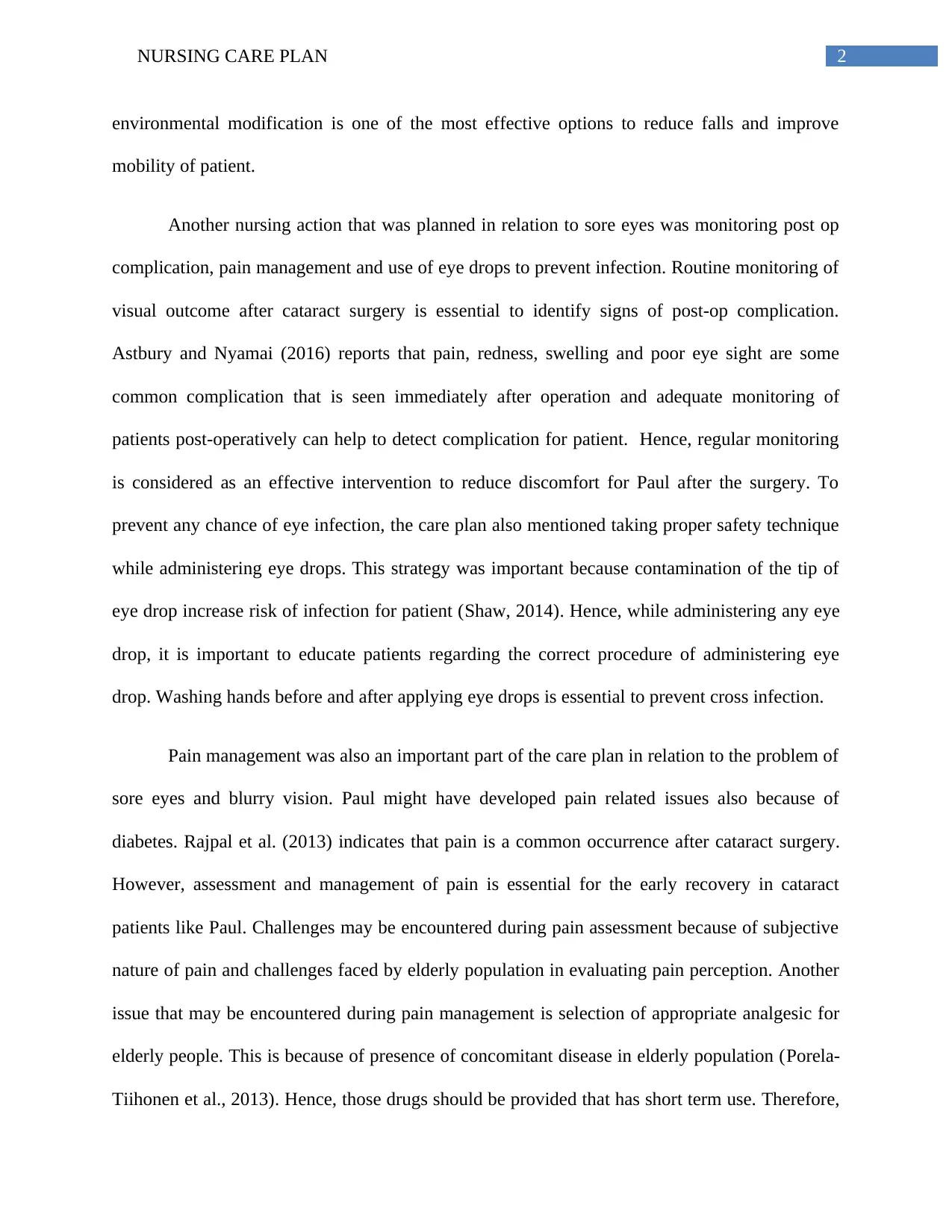
2NURSING CARE PLAN
environmental modification is one of the most effective options to reduce falls and improve
mobility of patient.
Another nursing action that was planned in relation to sore eyes was monitoring post op
complication, pain management and use of eye drops to prevent infection. Routine monitoring of
visual outcome after cataract surgery is essential to identify signs of post-op complication.
Astbury and Nyamai (2016) reports that pain, redness, swelling and poor eye sight are some
common complication that is seen immediately after operation and adequate monitoring of
patients post-operatively can help to detect complication for patient. Hence, regular monitoring
is considered as an effective intervention to reduce discomfort for Paul after the surgery. To
prevent any chance of eye infection, the care plan also mentioned taking proper safety technique
while administering eye drops. This strategy was important because contamination of the tip of
eye drop increase risk of infection for patient (Shaw, 2014). Hence, while administering any eye
drop, it is important to educate patients regarding the correct procedure of administering eye
drop. Washing hands before and after applying eye drops is essential to prevent cross infection.
Pain management was also an important part of the care plan in relation to the problem of
sore eyes and blurry vision. Paul might have developed pain related issues also because of
diabetes. Rajpal et al. (2013) indicates that pain is a common occurrence after cataract surgery.
However, assessment and management of pain is essential for the early recovery in cataract
patients like Paul. Challenges may be encountered during pain assessment because of subjective
nature of pain and challenges faced by elderly population in evaluating pain perception. Another
issue that may be encountered during pain management is selection of appropriate analgesic for
elderly people. This is because of presence of concomitant disease in elderly population (Porela-
Tiihonen et al., 2013). Hence, those drugs should be provided that has short term use. Therefore,
environmental modification is one of the most effective options to reduce falls and improve
mobility of patient.
Another nursing action that was planned in relation to sore eyes was monitoring post op
complication, pain management and use of eye drops to prevent infection. Routine monitoring of
visual outcome after cataract surgery is essential to identify signs of post-op complication.
Astbury and Nyamai (2016) reports that pain, redness, swelling and poor eye sight are some
common complication that is seen immediately after operation and adequate monitoring of
patients post-operatively can help to detect complication for patient. Hence, regular monitoring
is considered as an effective intervention to reduce discomfort for Paul after the surgery. To
prevent any chance of eye infection, the care plan also mentioned taking proper safety technique
while administering eye drops. This strategy was important because contamination of the tip of
eye drop increase risk of infection for patient (Shaw, 2014). Hence, while administering any eye
drop, it is important to educate patients regarding the correct procedure of administering eye
drop. Washing hands before and after applying eye drops is essential to prevent cross infection.
Pain management was also an important part of the care plan in relation to the problem of
sore eyes and blurry vision. Paul might have developed pain related issues also because of
diabetes. Rajpal et al. (2013) indicates that pain is a common occurrence after cataract surgery.
However, assessment and management of pain is essential for the early recovery in cataract
patients like Paul. Challenges may be encountered during pain assessment because of subjective
nature of pain and challenges faced by elderly population in evaluating pain perception. Another
issue that may be encountered during pain management is selection of appropriate analgesic for
elderly people. This is because of presence of concomitant disease in elderly population (Porela-
Tiihonen et al., 2013). Hence, those drugs should be provided that has short term use. Therefore,
⊘ This is a preview!⊘
Do you want full access?
Subscribe today to unlock all pages.

Trusted by 1+ million students worldwide
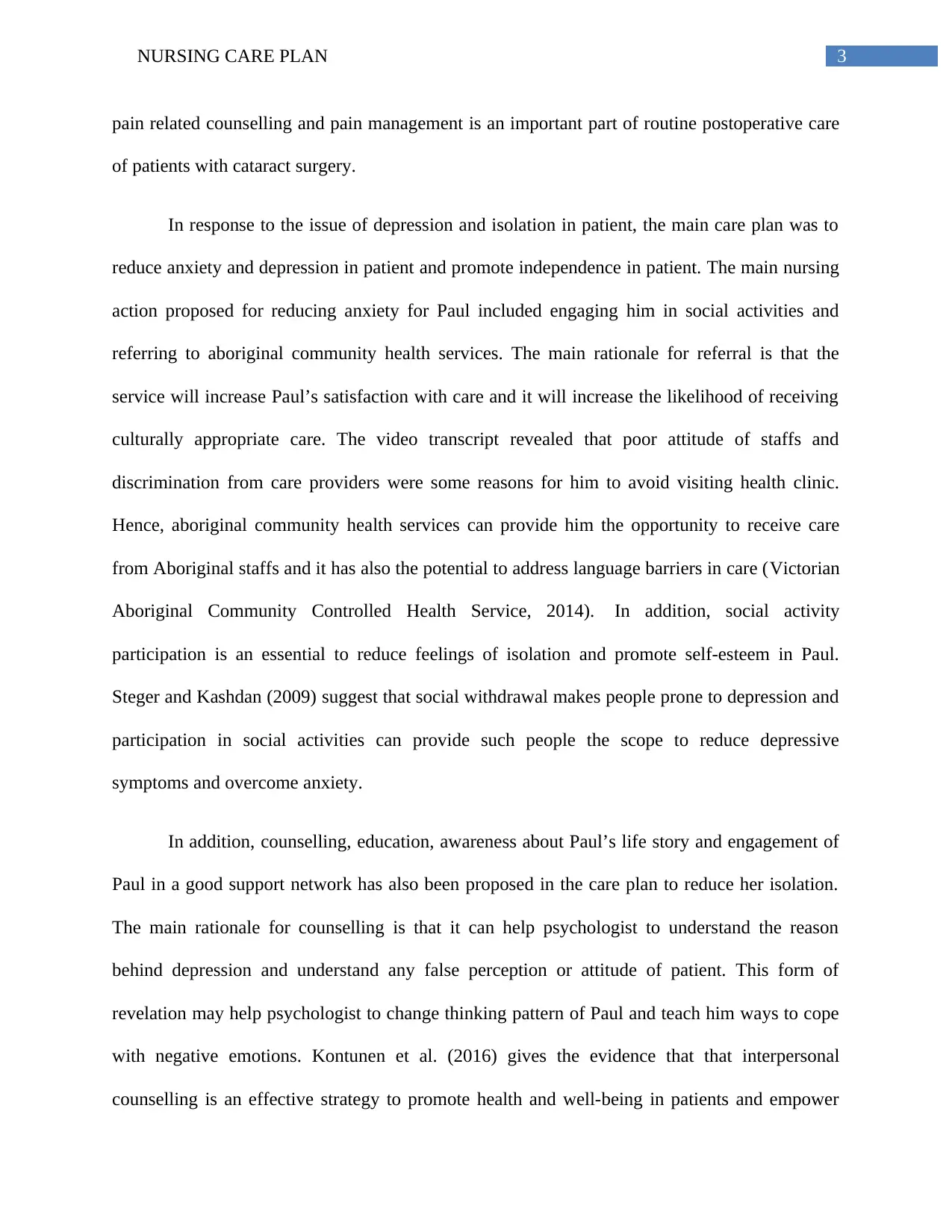
3NURSING CARE PLAN
pain related counselling and pain management is an important part of routine postoperative care
of patients with cataract surgery.
In response to the issue of depression and isolation in patient, the main care plan was to
reduce anxiety and depression in patient and promote independence in patient. The main nursing
action proposed for reducing anxiety for Paul included engaging him in social activities and
referring to aboriginal community health services. The main rationale for referral is that the
service will increase Paul’s satisfaction with care and it will increase the likelihood of receiving
culturally appropriate care. The video transcript revealed that poor attitude of staffs and
discrimination from care providers were some reasons for him to avoid visiting health clinic.
Hence, aboriginal community health services can provide him the opportunity to receive care
from Aboriginal staffs and it has also the potential to address language barriers in care (Victorian
Aboriginal Community Controlled Health Service, 2014). In addition, social activity
participation is an essential to reduce feelings of isolation and promote self-esteem in Paul.
Steger and Kashdan (2009) suggest that social withdrawal makes people prone to depression and
participation in social activities can provide such people the scope to reduce depressive
symptoms and overcome anxiety.
In addition, counselling, education, awareness about Paul’s life story and engagement of
Paul in a good support network has also been proposed in the care plan to reduce her isolation.
The main rationale for counselling is that it can help psychologist to understand the reason
behind depression and understand any false perception or attitude of patient. This form of
revelation may help psychologist to change thinking pattern of Paul and teach him ways to cope
with negative emotions. Kontunen et al. (2016) gives the evidence that that interpersonal
counselling is an effective strategy to promote health and well-being in patients and empower
pain related counselling and pain management is an important part of routine postoperative care
of patients with cataract surgery.
In response to the issue of depression and isolation in patient, the main care plan was to
reduce anxiety and depression in patient and promote independence in patient. The main nursing
action proposed for reducing anxiety for Paul included engaging him in social activities and
referring to aboriginal community health services. The main rationale for referral is that the
service will increase Paul’s satisfaction with care and it will increase the likelihood of receiving
culturally appropriate care. The video transcript revealed that poor attitude of staffs and
discrimination from care providers were some reasons for him to avoid visiting health clinic.
Hence, aboriginal community health services can provide him the opportunity to receive care
from Aboriginal staffs and it has also the potential to address language barriers in care (Victorian
Aboriginal Community Controlled Health Service, 2014). In addition, social activity
participation is an essential to reduce feelings of isolation and promote self-esteem in Paul.
Steger and Kashdan (2009) suggest that social withdrawal makes people prone to depression and
participation in social activities can provide such people the scope to reduce depressive
symptoms and overcome anxiety.
In addition, counselling, education, awareness about Paul’s life story and engagement of
Paul in a good support network has also been proposed in the care plan to reduce her isolation.
The main rationale for counselling is that it can help psychologist to understand the reason
behind depression and understand any false perception or attitude of patient. This form of
revelation may help psychologist to change thinking pattern of Paul and teach him ways to cope
with negative emotions. Kontunen et al. (2016) gives the evidence that that interpersonal
counselling is an effective strategy to promote health and well-being in patients and empower
Paraphrase This Document
Need a fresh take? Get an instant paraphrase of this document with our AI Paraphraser
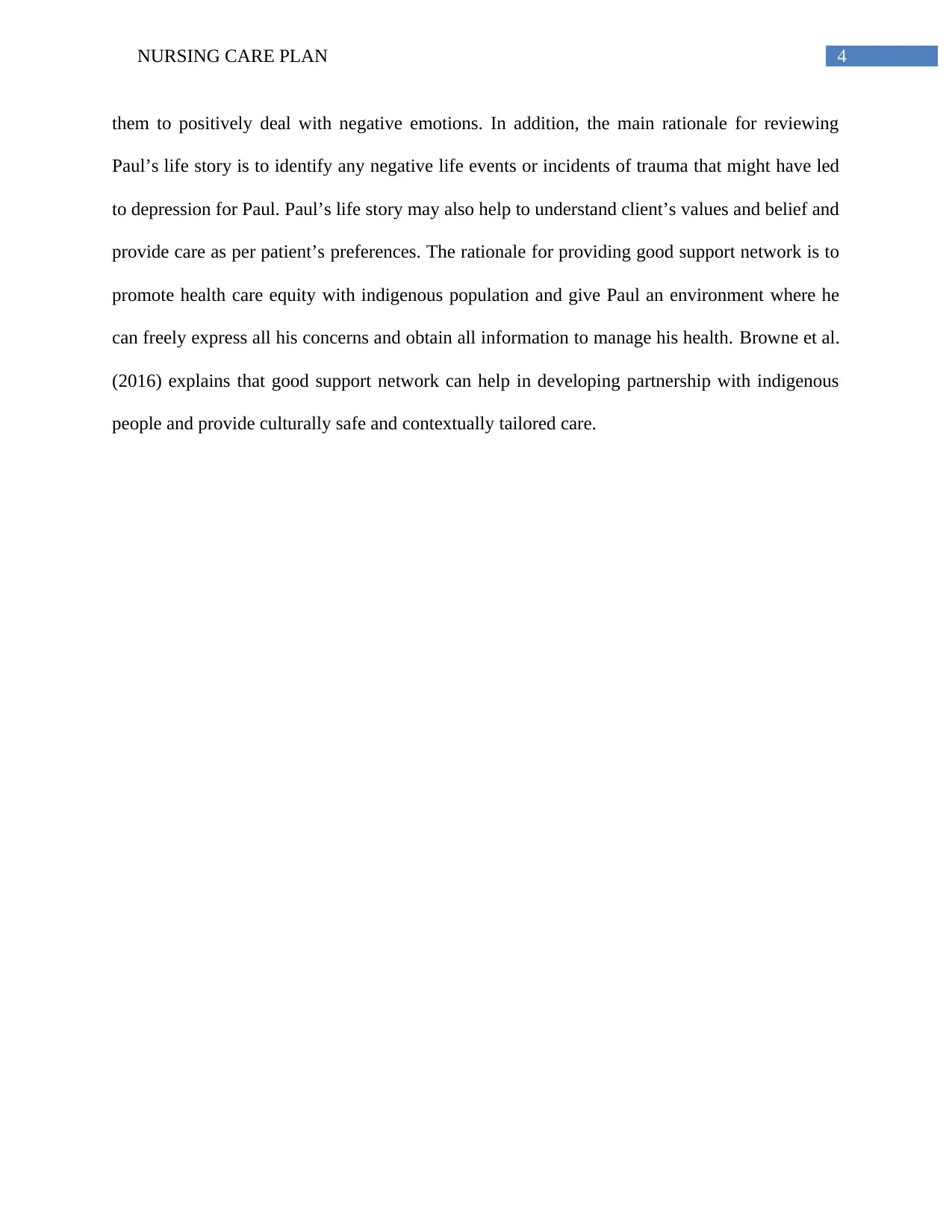
4NURSING CARE PLAN
them to positively deal with negative emotions. In addition, the main rationale for reviewing
Paul’s life story is to identify any negative life events or incidents of trauma that might have led
to depression for Paul. Paul’s life story may also help to understand client’s values and belief and
provide care as per patient’s preferences. The rationale for providing good support network is to
promote health care equity with indigenous population and give Paul an environment where he
can freely express all his concerns and obtain all information to manage his health. Browne et al.
(2016) explains that good support network can help in developing partnership with indigenous
people and provide culturally safe and contextually tailored care.
them to positively deal with negative emotions. In addition, the main rationale for reviewing
Paul’s life story is to identify any negative life events or incidents of trauma that might have led
to depression for Paul. Paul’s life story may also help to understand client’s values and belief and
provide care as per patient’s preferences. The rationale for providing good support network is to
promote health care equity with indigenous population and give Paul an environment where he
can freely express all his concerns and obtain all information to manage his health. Browne et al.
(2016) explains that good support network can help in developing partnership with indigenous
people and provide culturally safe and contextually tailored care.
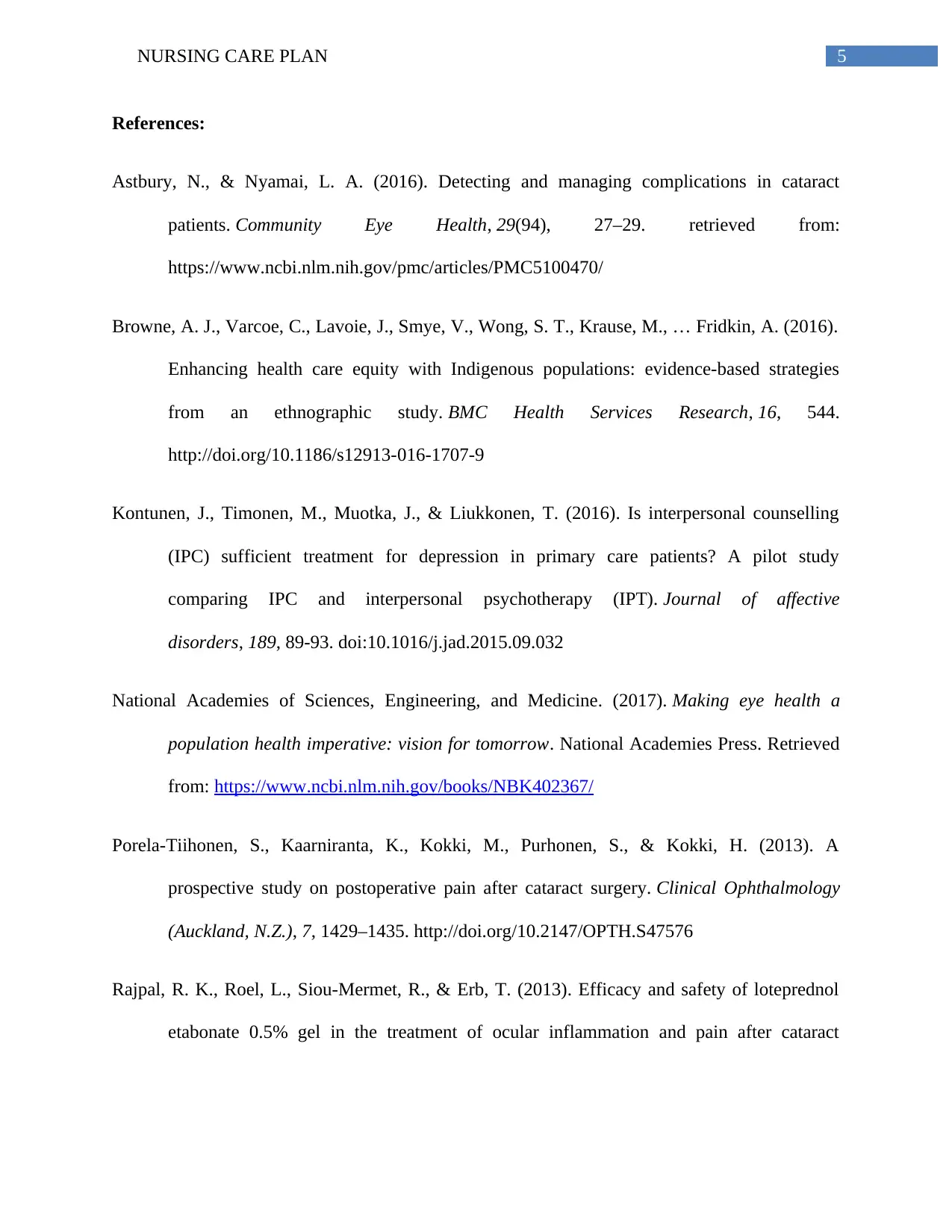
5NURSING CARE PLAN
References:
Astbury, N., & Nyamai, L. A. (2016). Detecting and managing complications in cataract
patients. Community Eye Health, 29(94), 27–29. retrieved from:
https://www.ncbi.nlm.nih.gov/pmc/articles/PMC5100470/
Browne, A. J., Varcoe, C., Lavoie, J., Smye, V., Wong, S. T., Krause, M., … Fridkin, A. (2016).
Enhancing health care equity with Indigenous populations: evidence-based strategies
from an ethnographic study. BMC Health Services Research, 16, 544.
http://doi.org/10.1186/s12913-016-1707-9
Kontunen, J., Timonen, M., Muotka, J., & Liukkonen, T. (2016). Is interpersonal counselling
(IPC) sufficient treatment for depression in primary care patients? A pilot study
comparing IPC and interpersonal psychotherapy (IPT). Journal of affective
disorders, 189, 89-93. doi:10.1016/j.jad.2015.09.032
National Academies of Sciences, Engineering, and Medicine. (2017). Making eye health a
population health imperative: vision for tomorrow. National Academies Press. Retrieved
from: https://www.ncbi.nlm.nih.gov/books/NBK402367/
Porela-Tiihonen, S., Kaarniranta, K., Kokki, M., Purhonen, S., & Kokki, H. (2013). A
prospective study on postoperative pain after cataract surgery. Clinical Ophthalmology
(Auckland, N.Z.), 7, 1429–1435. http://doi.org/10.2147/OPTH.S47576
Rajpal, R. K., Roel, L., Siou-Mermet, R., & Erb, T. (2013). Efficacy and safety of loteprednol
etabonate 0.5% gel in the treatment of ocular inflammation and pain after cataract
References:
Astbury, N., & Nyamai, L. A. (2016). Detecting and managing complications in cataract
patients. Community Eye Health, 29(94), 27–29. retrieved from:
https://www.ncbi.nlm.nih.gov/pmc/articles/PMC5100470/
Browne, A. J., Varcoe, C., Lavoie, J., Smye, V., Wong, S. T., Krause, M., … Fridkin, A. (2016).
Enhancing health care equity with Indigenous populations: evidence-based strategies
from an ethnographic study. BMC Health Services Research, 16, 544.
http://doi.org/10.1186/s12913-016-1707-9
Kontunen, J., Timonen, M., Muotka, J., & Liukkonen, T. (2016). Is interpersonal counselling
(IPC) sufficient treatment for depression in primary care patients? A pilot study
comparing IPC and interpersonal psychotherapy (IPT). Journal of affective
disorders, 189, 89-93. doi:10.1016/j.jad.2015.09.032
National Academies of Sciences, Engineering, and Medicine. (2017). Making eye health a
population health imperative: vision for tomorrow. National Academies Press. Retrieved
from: https://www.ncbi.nlm.nih.gov/books/NBK402367/
Porela-Tiihonen, S., Kaarniranta, K., Kokki, M., Purhonen, S., & Kokki, H. (2013). A
prospective study on postoperative pain after cataract surgery. Clinical Ophthalmology
(Auckland, N.Z.), 7, 1429–1435. http://doi.org/10.2147/OPTH.S47576
Rajpal, R. K., Roel, L., Siou-Mermet, R., & Erb, T. (2013). Efficacy and safety of loteprednol
etabonate 0.5% gel in the treatment of ocular inflammation and pain after cataract
⊘ This is a preview!⊘
Do you want full access?
Subscribe today to unlock all pages.

Trusted by 1+ million students worldwide
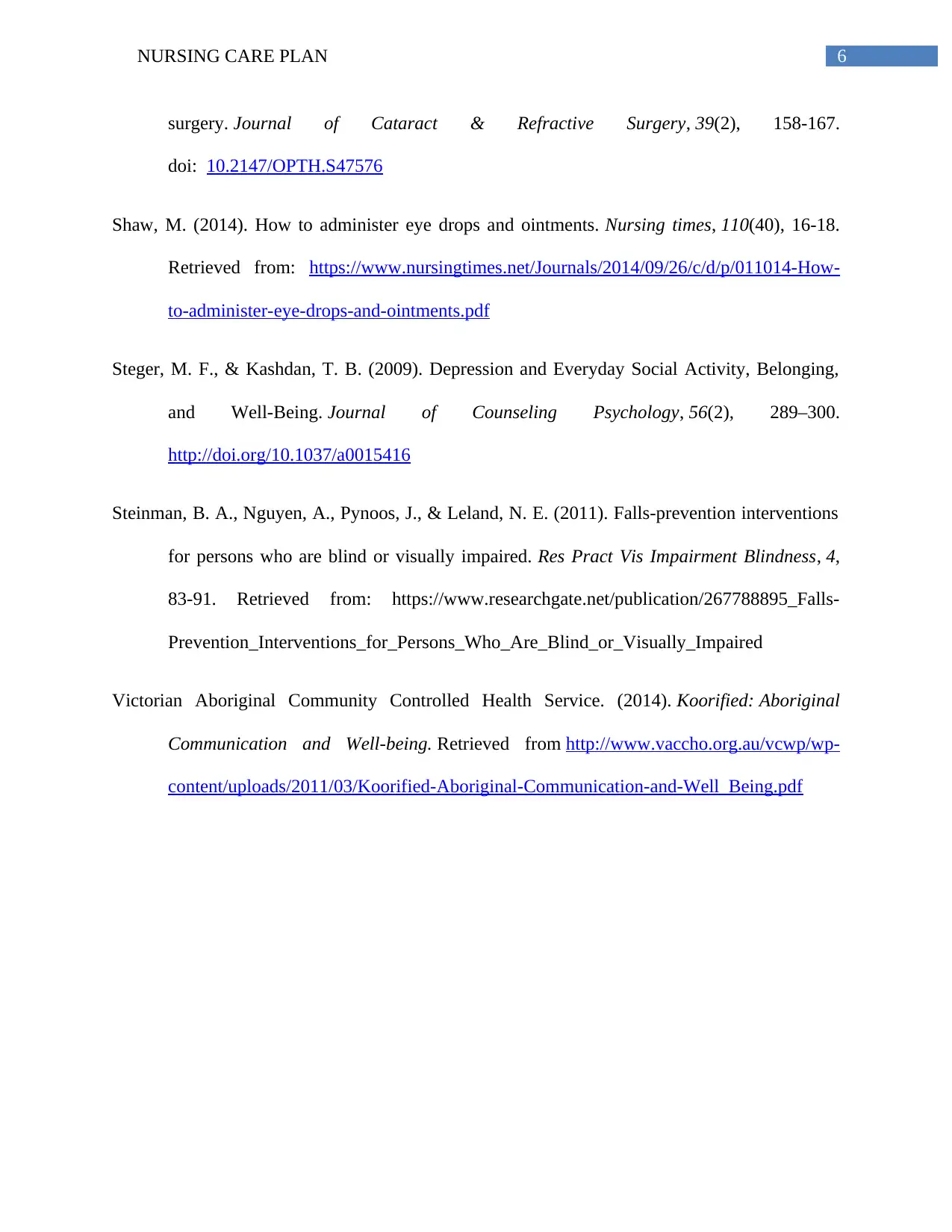
6NURSING CARE PLAN
surgery. Journal of Cataract & Refractive Surgery, 39(2), 158-167.
doi: 10.2147/OPTH.S47576
Shaw, M. (2014). How to administer eye drops and ointments. Nursing times, 110(40), 16-18.
Retrieved from: https://www.nursingtimes.net/Journals/2014/09/26/c/d/p/011014-How-
to-administer-eye-drops-and-ointments.pdf
Steger, M. F., & Kashdan, T. B. (2009). Depression and Everyday Social Activity, Belonging,
and Well-Being. Journal of Counseling Psychology, 56(2), 289–300.
http://doi.org/10.1037/a0015416
Steinman, B. A., Nguyen, A., Pynoos, J., & Leland, N. E. (2011). Falls-prevention interventions
for persons who are blind or visually impaired. Res Pract Vis Impairment Blindness, 4,
83-91. Retrieved from: https://www.researchgate.net/publication/267788895_Falls-
Prevention_Interventions_for_Persons_Who_Are_Blind_or_Visually_Impaired
Victorian Aboriginal Community Controlled Health Service. (2014). Koorified: Aboriginal
Communication and Well-being. Retrieved from http://www.vaccho.org.au/vcwp/wp-
content/uploads/2011/03/Koorified-Aboriginal-Communication-and-Well_Being.pdf
surgery. Journal of Cataract & Refractive Surgery, 39(2), 158-167.
doi: 10.2147/OPTH.S47576
Shaw, M. (2014). How to administer eye drops and ointments. Nursing times, 110(40), 16-18.
Retrieved from: https://www.nursingtimes.net/Journals/2014/09/26/c/d/p/011014-How-
to-administer-eye-drops-and-ointments.pdf
Steger, M. F., & Kashdan, T. B. (2009). Depression and Everyday Social Activity, Belonging,
and Well-Being. Journal of Counseling Psychology, 56(2), 289–300.
http://doi.org/10.1037/a0015416
Steinman, B. A., Nguyen, A., Pynoos, J., & Leland, N. E. (2011). Falls-prevention interventions
for persons who are blind or visually impaired. Res Pract Vis Impairment Blindness, 4,
83-91. Retrieved from: https://www.researchgate.net/publication/267788895_Falls-
Prevention_Interventions_for_Persons_Who_Are_Blind_or_Visually_Impaired
Victorian Aboriginal Community Controlled Health Service. (2014). Koorified: Aboriginal
Communication and Well-being. Retrieved from http://www.vaccho.org.au/vcwp/wp-
content/uploads/2011/03/Koorified-Aboriginal-Communication-and-Well_Being.pdf
1 out of 7
Related Documents
Your All-in-One AI-Powered Toolkit for Academic Success.
+13062052269
info@desklib.com
Available 24*7 on WhatsApp / Email
![[object Object]](/_next/static/media/star-bottom.7253800d.svg)
Unlock your academic potential
Copyright © 2020–2025 A2Z Services. All Rights Reserved. Developed and managed by ZUCOL.





